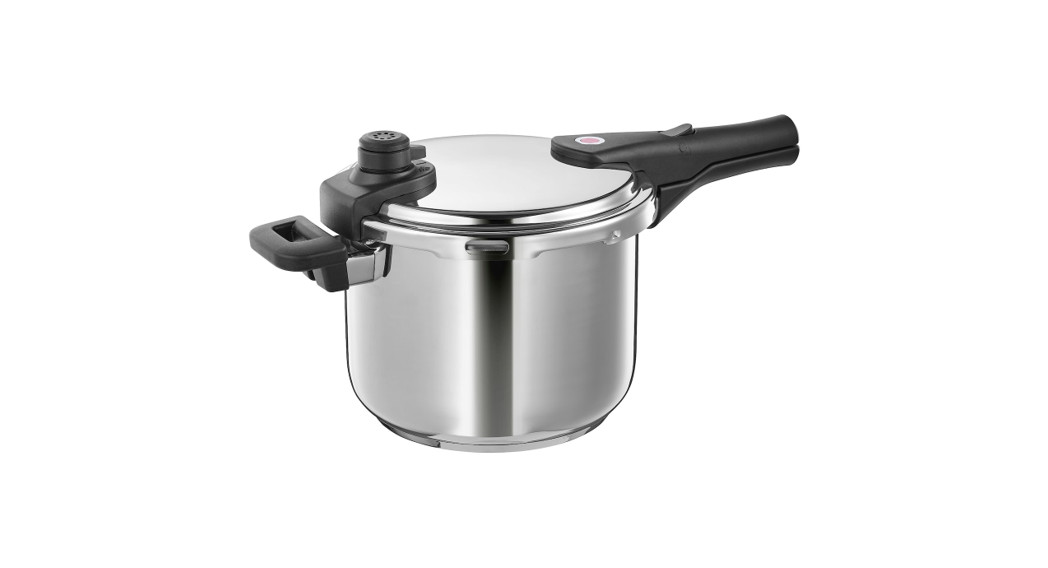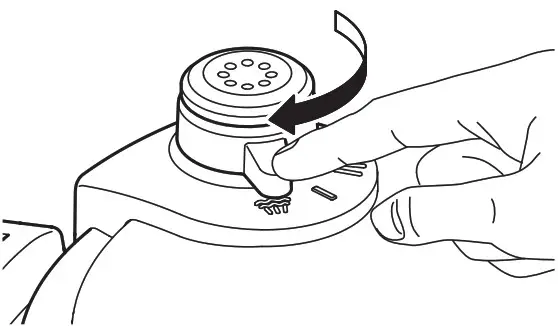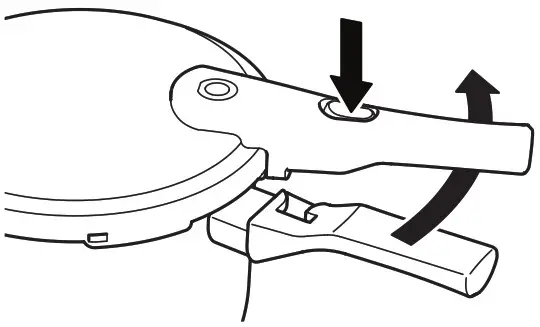 IKEA 365+Pressure Cooker Autocuiseur90483150
IKEA 365+Pressure Cooker Autocuiseur90483150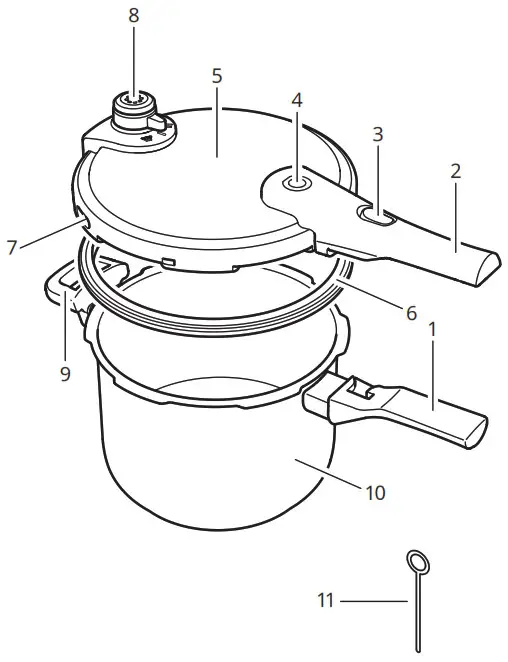
Name of parts
| 1. Pot handle | 7. Safety pressure window |
| 2. Lid handle | 8. Pressure regulator |
| 3. Handle release button | 9. Side handle |
| 4. Safety valve | 10. Pot |
| 5. Lid | 11. Pin |
| 6. Gasket |
IMPORTANT SAFEGUARDS – please read before use
Read all the instructions. Do not let children near the pressure cooker when in use. Do not put the pressure cooker into a heated oven. Extreme caution must be used when moving a pressure cooker containing hot liquids. Do not touch hot surfaces. Use the handles and knobs. If necessary, use protection. Do not use the pressure cooker for a purpose other than the one for which it is intended.This pressure cooker cooks under pressure. Scalds may result from inappropriate use of the pressure cooker. Make sure that the pressure cooker is properly closed before applying heat. See section “Instructions for use”. When the normal operating pressure is reached, turn the heat down so all the liquid, which creates the steam, does not evaporate. Never force open the pressure cooker. Do not open before making sure that its internal pressure has completely dropped. See section “Instructions for use”.
Never use your pressure cooker without adding water, this would seriously damage it. Do not fill the pressure cooker above 2/3 of its capacity (see “MAX” mark inside the pot). When cooking food that expands during cooking, such as rice or dehydrated vegetables, do not fill the pressure cooker above ½ of its capacity (see “½” mark inside the pot). Over filling may cause a risk of clogging the vent pipe and developing excess pressure. See section “Instructions for use”.
Use the appropriate heat sources according to the instructions for use. After cooking meat with a skin (e.g. ox tongue) which may swell under the effect of pressure, do not prick the meat while the skin is swollen; hot water could squirt out and you might be scalded.When cooking doughy food, gently shake the pressure cooker before opening the lid to avoid food ejection. Be aware that certain foods, such as applesauce, cranberries, pearl barley, oatmeal or other cereals, split peas, noodles, macaroni, rhubarb, or spaghetti can foam, froth, and sputter, and clog the pressure release device (steam vent). These foods should not be cooked in a pressure cooker. Before each use, check that the valves are not obstructed. See section “Instructions for use”.Never use the pressure cooker in its pressurised mode for deep or shallow frying of food. Do not tamper with any of the safety systems beyond the maintenance instructions specified in the instructions for use.Only use manufacturer’s spare parts in accordance with the relevant model.
If you have any questions, please contact your nearest IKEA store/Customer service or see www.ikea.com.
KEEP THESE INSTRUCTIONS.
Technical information
Working pressure: 0,6 bar (setting 1) and 1,0 bar (setting 2).Usable capacity: 6 litres.Licence holder: IKEA of Sweden, Tulpanvägen 8, SE-343 81 ÄLMHULT, Sweden. Model: 90483150 The pressure cooker is UL certified.
Safety information
- The pressure cooker comes with a pressure regulator in the lid which keeps the desired pressure setting constant.
- The pressure cooker has several safety systems to ensure that your pressure cooker will function safely, even in the event of a technical fault. The pressure regulator 8 ensures the pressure remains constant within the pressure cooker. It is possible that some steam may continuously escape during use. The safety valve 4 releases any excess pressure if the pressure regulator malfunctions. If the pressure regulator 8 and the safety valve 4 both malfunction, excess pressure will escape through the safety pressure window 7. The release button for the lid 3 can only be pressed down to open the pot when the pressure has been equalised and the red safety valve 4 drops down.
General safety adviceBe sure to check before every use that the pressure regulator 8 and the safety valve 4 are manoeuvrable and not blocked up (see section “Instructions for use”). Always ensure that the pressure cooker is closed correctly before putting it on the hob (see section “Instructions for use”).The pressure regulator 8 should never be covered by any objects. Always ensure the pressure regulator 8 is facing away from you during use and that it is not facing where others may pass by. In the event of a fault, a lot of steam will escape. Should steam escape from the safety valve 4 or the safety pressure window 7, immediately turn off the heat supply since the pressure inside the pressure cooker is too high. Do not continue to use the pressure cooker until the problem has been corrected (see section “Troubleshooting”).To avoid damaging the pressure cooker, you should ensure that the pot always contains at least 0.25 litres of liquid, so that sufficient steam can be produced and the pressure cooker doesn’t overheat and boil dry.
WARNING: Repairs to the pressure cooker may only be made by an authorised professional.
Good to know The pressure cooker is suitable for use on all types of hobs, including induction hobs. The pressure cooker can be used as a traditional pot (without the lid) to brown food before pressure cooking.By placing the pressure cooker on a hob with the same or a smaller diameter you can save energy. Always lift the pressure cooker when moving it on a glass ceramic hob to avoid the risk of scratching the hob.Bear in mind that the pressure cooker gets hot during use. Always handle with pot holders. Never let the pressure cooker boil dry, this would seriously damage it.The pressure cooker is designed exclusively for cooking, not for storing food. Food that is stored in the pressure cooker for a longer period may affect the surface and take on the taste of metal. When the pressure cooker is used on a gas hob make certain the flames do not touch the handles.
The pressure cooker is suitable for use on all types of hobs, including induction hobs. The pressure cooker can be used as a traditional pot (without the lid) to brown food before pressure cooking.By placing the pressure cooker on a hob with the same or a smaller diameter you can save energy. Always lift the pressure cooker when moving it on a glass ceramic hob to avoid the risk of scratching the hob.Bear in mind that the pressure cooker gets hot during use. Always handle with pot holders. Never let the pressure cooker boil dry, this would seriously damage it.The pressure cooker is designed exclusively for cooking, not for storing food. Food that is stored in the pressure cooker for a longer period may affect the surface and take on the taste of metal. When the pressure cooker is used on a gas hob make certain the flames do not touch the handles.
Instructions for use
Before each useBefore cooking with the pressure cooker, you should check all the safety functions to avoid causing any damage to the pressure cooker.
- Check that the openings for the pressure regulator 8 on the inside of the lid are clean.
- Should this not be the case, clean the pressure regulator 8 (see section “Cleaning and storing”).
- Check that the safety valve 4 is movable and not stuck.
- Check that the gasket 6 is not damaged in any way, i.e. that it is not split.Note! Over time the gasket can become hard and will therefore no longer provide an air-tight seal. This will lead to steam escaping from the rim of the lid and the gasket will therefore require replacing. For replacement gaskets, please contact your nearest IKEA Store/ Customer service or visit www.ikea.com.
How to use the pressure cooker
- Fill the pot with food and/or liquid. Caution! Never fill the pressure cooker with food and liquid above the “MAX” mark on the inside of the pot. This corresponds to a maximum of 4 litres (for pressure cooker with usable capacity of 6 litres). When cooking food that swells, such as rice or pulses, you should never fill the pot above the “½” mark on the inside of the pot. This will prevent the food from reaching the lid and potentially blocking the pressure regulator and the safety valve.
- Place the lid 5 on the pot 10 in such a way that the circular mark on the lid is pointing to the circular mark on the pot handle’s lower part 1.

- Turn the lid until the lid handle 2 and the pot handle 1 are aligned and audibly click into place.
- Choose the desired cooking setting on the pressure regulator 8: I; Slow cooking (1) II; Fast cooking (2) For more cooking advice, please read more in the document Table of cooking times.
- Place the pressure cooker on a hob which is a similar size to the base of the pressure cooker. Caution! The hob should not be bigger than the base of the pressure cooker. Otherwise this could lead to too much heat rising up the sides of the base, thereby damaging the plastic handles.
- Turn the hob onto the highest setting. As soon as there is pressure in the pressure cooker, the red safety valve 4 will move upwards thereby locking the lid. Note! At the beginning of the cooking time, a little steam may emerge from the safety valve.
- As soon as steam starts to come out of the pressure regulator 8, lower the temperature of the hob to around 1/2 so that only a small amount of steam comes out. The pressure cooker starts now cooking food quickly and saving energy.
Opening the pressure cooker
Caution! If the red safety valve 4 is still raised, the pressure cooker is still pressurised and the lid cannot be opened. Under no circumstances should you attempt to force the lid open, as the sudden release of pressure could result in scalding. The pressure cooker will only open once the red safety valve 4 has dropped down. This can be done either of three ways. Never entirely immerse the pressure cooker in water. Otherwise the pressure will instantly drop which can lead to the base as well as the food being ruined.
Three ways to open the pressure cooker
There are three methods to reduce pressure in the pressure cooker in order to be able to open it;
Method 1: Releasing steam
This method requires releasing as much steam as possible until the pressure in the pressure cooker has decreased enough to be able to remove the lid.Warning! Be aware that the pressure regulator 8 is facing away from you when you open the pressure cooker as this method means that hot steam will escape from the pressure cooker. Do not cover the pressure regulator 8 with your hand when turning the pressure regulator to steam release as a lot of steam will escape right up. You should therefore be careful not to burning your hand.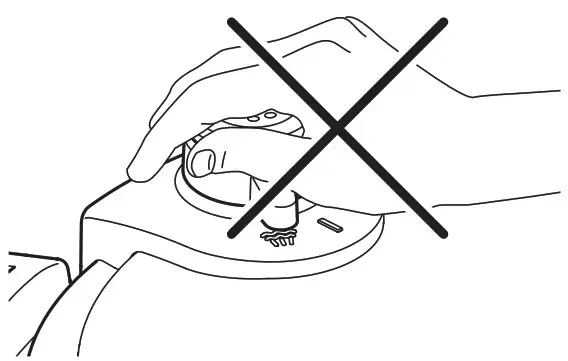
- Remove the pressure cooker from the hob.
- Carefully turn the pressure regulator 8 to the steam releasing setting.

- Wait until the pressure has equalised and the red safety valve 4 falls back down.
- Note! As soon as the red safety valve 4 falls back down, the temperature inside the pressure cooker is still almost 100 °C.
- Press the handle release button 3 and turn the lid anticlockwise at the same time until the circular mark on the lid is pointing to the circular mark on the pot handle 1. Note! As soon as you press the handle release button 3, some residual steam may escape.

- Remove the lid from the pot.
Method 2: Saving energy
Method 2 requires the pressure cooker to be turned off a few minutes before the food has finished cooking, leaving the pressure cooker on the hob. This uses the residual heat optimally and saves energy.
- Wait until the pressure has stabilised and the red safety valve 4 drops down. Note! When the safety valve 4 drops down, the temperature inside the pressure cooker is still around 100 °C.
- Press the handle release button 3 and turn the lid anticlockwise at the same time until the circular mark on the lid is pointing to the circular mark on the pot handle 1.Note! As soon as you press the handle release button 3, some residual steam may escape.
- Remove the lid from the pot.
Method 3: Saving timeMethod 3 requires you to remove the pressure cooker from the hob once the food has finished cooking. In order to be able to open the lid straight away, the pressure in the base has to be released manually. This method in particular saves time.
- Hold the pressure cooker under running water until the safety valve 4 drops down (the pressure of the water should not be too high). Caution! Take care to prevent the water jet from hitting the pressure regulator 8 or the safety valve 4, as water might otherwise get inside the pot and dilute your food.
- Press the handle release button 3 and turn the lid anticlockwise at the same time until the circular mark on the lid is pointing to the circular mark on the pot handle 1. Note! As soon as you press the handle release button 3, some residual steam may escape.
- Remove the lid from the pot.
Cleaning and storing
Your pressure cooker is easy to clean and maintain. In order to enjoy your pressure cooker for a long time, please ensure you always observe the following cleaning instructions. Frequency of cleaning:
| Activity | Frequency |
| Clean pot 10 | After each use |
| Clean pressure regulator8 | When dirty |
| Clean lid 5 | After each use |
| Clean gasket 6 | After each use |
| Replace gasket 6 | When needed. Contact your nearest IKEA store/ Customer service or visit www.ikea.com for support. |
How to clean the pressure cookerAlways wash the pressure cooker after use.The pressure cooker should always be washed by hand.
Do not use steel wool or anything that may scratch the surface.If possible you should clean the pressure cooker directly after use so that any leftovers do not dry and stick to the pot
How to clean the pot (10)Clean the pot 10 after each use:
- Wash the pot by hand with hot water and a mild detergent.
- Rinse with clean water.
- Dry the pot with a tea towel to avoid any water marks.
How to clean the lid (5)Caution! The lid should not be washed in the dishwasher.
- Remove the pressure regulator 8 by pulling it upwards.
- Wash the lid with hot water and a mild detergent. If the lid is particularly dirty, soak it for a little while in water and a mild detergent.
- Rinse the pressure regulator 8 in clean, hot water.
- Rinse the lid 5 under hot water.
- Dry the lid with a tea towel to avoid any water marks.
- Re-insert the pressure regulator 8 into the lid.
How to clean the gasket (6)Note! The gasket should be replaced once a year if you use the pressure cooker regularly (spare part number 10056097). Please contact your nearest IKEA store/ Customer service or see www.ikea.com for support.
- Remove the gasket from the lid.
- Rinse the gasket in clean, hot water.
- Dry the gasket with a tea towel.
- Note! The gasket should not be squashed or deformed during storage. It is therefore advisable to place the gasket back into the lid during storage.
How to clean the safety valve (4)Check that the safety valve (4) is manoeuvrable and not blocked up every time before use.
- Poke the safety valve (4) using the included thin pin (11) and check that the safety valve (4) moves smoothly.
- Check that it is not clogged with remains of food. Remove the remains of food if necessary.
Storing the pressure cookerCaution! The pressure cooker should never be stored with the lid on. If there is no ventilation then condensation may develop which could lead to a build up of bad smells and may even damage the pressure cooker.
- Store the gasket in the lid.
- Store the pot and the lid separately
Troubleshooting
Warning! As soon as uncontrolled steam emerges, remove the pressure cooker form the hob. The pressure cooker is not to be used again until the error has been corrected. Only a slight emergence of steam from the pressure regulator 8 is normal.What to do if:
| Problem | Possible cause | Solution |
| Steam is escaping from between the lid and the pot. | 1. Pressure cooker not closed correcdy.2. Gasket is dirty.3. Gasket is broken/worn away | 1. Close the pressure cooker again correcdy.2. Clean the gaskeL3. Replace the gasket (1 x years |
| No steam is coming from the pressure regulator. | 1. Steam is escaping from between the lid and the pot.2. Pressure regulator is dirty.3.Not enough liquid in the pressure cooker.Heat supply too low. | 1. Replace the gasket (1 x years2. Clean the pressure regulator (see section “Cleaning and storing”).3. Slowly cool down the pressure cooker and fill with at least 0.25 I liquid.4. Increase the heat supply (turn the hob to a higher setting). |
| Too much steam is coming from the pressure regulator. | 1. Heat supply too high.2. Pressure regulator is dirty. | 1. Decrease the heat suppJy(turn the hob to a lower setting).2. Clean the pressure regulator (see section “Cleaning and storing”). |
| Steam is escaping from the sides of the pressure regulator. | 1. The pressure regulator is not correcdy fitted. | 1. Fit the pressure regulator correcdy and tighten the union nut on the inside of the lid using the key 10. |
| Steam is escaping from the safety opening. | 1. The protective caps in the pressure regulator are defective or not properly fitted.2. The pressure regulator is soiled.3. The pressure regulator is defective. | 1. Check the safety caps (see section “Cleaning and storing”).2. Clean the pressure regulator (see section “Cleaning ancl storing”).3. Contact your nearest IKEA store/Customer service or see www.ikea.com for supporL |
| The lid does not open. | 1. Thexistoomuchpmssurein the pressurecooker. | 1. Follow the instructions in section ”Opening the pressure cooker™. |
References
[xyz-ips snippet=”download-snippet”]

